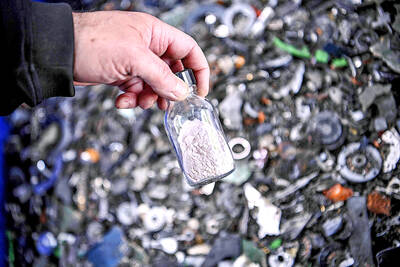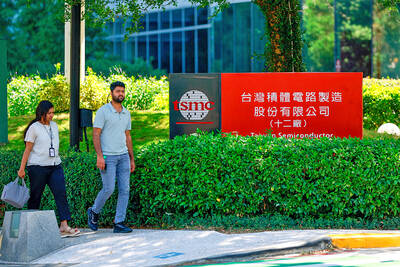With an approval rating of just two percent, Peruvian President Dina Boluarte might be the world’s most unpopular leader, according to pollsters. Protests greeted her rise to power 29 months ago, and have marked her entire term — joined by assorted scandals, investigations, controversies and a surge in gang violence.
The 63-year-old is the target of a dozen probes, including for her alleged failure to declare gifts of luxury jewels and watches, a scandal inevitably dubbed “Rolexgate.”
She is also under the microscope for a two-week undeclared absence for nose surgery — which she insists was medical, not cosmetic — and is being investigated for her role in a police crackdown that caused the deaths of 50 protesters.

Photo: EPA-EFE
Against that bleak backdrop, Boluarte’s never-high popularity hit rock bottom this month.
The Ipsos polling agency found she had a two-percent approval rating, down from 21 percent when she took office.
“We might be talking about a world record of sustained presidential disapproval,” Ipsos Peru president Alfredo Torres said.
It is the lowest score Ipsos has measured in any of the other 90 countries it surveys, Torres said.
Yet as far as recent Peruvian presidents go, she is not just a survivor, but positively an elder stateswoman.
The South American nation has had six presidents in eight years, and if Boluarte lasts to the end of her term next year, she would be the longest-serving of them all.
Despite not having a party in the Peruvian Congress, she has managed to stay in power with the backing of Peru’s majority right-wing parties.
Analysts say voter lethargy and political expediency have so far helped Boluarte buck the trend of prematurely ousted Peruvian leaders.
“In Peru, there is a political paradox: Boluarte is the weakest president of the last decade,” political analyst Augusto Alvarez of the University of the Pacific said.
However, her weakness is “also her strength,” he said, adding that a lame-duck president is politically useful for Congress.
“It is a great business to have a fragile president whom they [lawmakers] use” to entrench their own power and pass laws beneficial to allies and backers, Alvarez said.
Transparency International’s Peruvian chapter Proetica has cited Congress for “counter-reforms, setbacks in anti-corruption instruments ... and shielding of members of Congress who are ethically questioned.”
Boluarte has other factors counting in her favor.
Congress is seemingly keeping her around for lack of a better, consensus, candidate.
Another plus for Boluarte: Peru’s economy has been performing well, with GDP growing 3.3 percent last year and 3.9 percent in the first quarter of this year — a steep improvement from the 2020 recession blamed on COVID-19 pandemic lockdowns.
Peru’s inflation rate is one of the lowest in the region.
“The economy continues to function, there is enormous resilience, and the population’s income is growing,” said Alvarez.
However, this might have little to do with policy, observers say, and more with external factors such as rising copper prices. Peru is one of the top producers of the metal.
On the street, there is little love for Boluarte, as Peru battles a surge in gang violence characterized by a wave of killings linked to extortion rackets.
Boluarte “has no empathy, she is an incapable president, she does not solve the security problem,” said Saturnino Conde, a 63-year-old teacher.
At frequent marches against the president, the catchphrase: “Dina, Asesina!” (Dina, Murderer!) has become a popular refrain.
However, a full-out rebellion appears unlikely, say analysts.
Peruvians “feel it’s not worth it: If she resigns or is dismissed, she would be replaced by a member of Congress, but Congress also has a terrible image,” Ipsos manager Torres said.
In addition, “there is no other candidate that captivates, which is why people are not in a hurry to remove her from power.”

RECYCLE: Taiwan would aid manufacturers in refining rare earths from discarded appliances, which would fit the nation’s circular economy goals, minister Kung said Taiwan would work with the US and Japan on a proposed cooperation initiative in response to Beijing’s newly announced rare earth export curbs, Minister of Economic Affairs Kung Ming-hsin (龔明鑫) said yesterday. China last week announced new restrictions requiring companies to obtain export licenses if their products contain more than 0.1 percent of Chinese-origin rare earths by value. US Secretary of the Treasury Scott Bessent on Wednesday responded by saying that Beijing was “unreliable” in its rare earths exports, adding that the US would “neither be commanded, nor controlled” by China, several media outlets reported. Japanese Minister of Finance Katsunobu Kato yesterday also

‘DRAMATIC AND POSITIVE’: AI growth would be better than it previously forecast and would stay robust even if the Chinese market became inaccessible for customers, it said Taiwan Semiconductor Manufacturing Co (TSMC, 台積電) yesterday raised its full-year revenue growth outlook after posting record profit for last quarter, despite growing market concern about an artificial intelligence (AI) bubble. The company said it expects revenue to expand about 35 percent year-on-year, driven mainly by faster-than-expected demand for leading-edge chips for AI applications. The world’s biggest contract chipmaker in July projected that revenue this year would expand about 30 percent in US dollar terms. The company also slightly hiked its capital expenditure for this year to US$40 billion to US$42 billion, compared with US$38 billion to US$42 billion it set previously. “AI demand actually

Jensen Huang (黃仁勳), founder and CEO of US-based artificial intelligence chip designer Nvidia Corp and Taiwan Semiconductor Manufacturing Co (TSMC, 台積電) on Friday celebrated the first Nvidia Blackwell wafer produced on US soil. Huang visited TSMC’s advanced wafer fab in the US state of Arizona and joined the Taiwanese chipmaker’s executives to witness the efforts to “build the infrastructure that powers the world’s AI factories, right here in America,” Nvidia said in a statement. At the event, Huang joined Y.L. Wang (王英郎), vice president of operations at TSMC, in signing their names on the Blackwell wafer to

Taiwan-based GlobalWafers Co., the world’s third largest silicon wafer supplier, on Wednesday opened a 12-inch silicon wafer plant in Novara, northern Italy - the country’s most advanced silicon wafer facility to date. The new plant, coded “Fab300,” was launched by GlobalWafers’ Italian subsidiary MEMC Electronics Materials S.p.A at a ceremony attended by Taiwan’s representative to Italy Vincent Tsai (蔡允中), MEMC President Marco Sciamanna and Novara Mayor Alessandro Canelli. GlobalWafers Chairwoman Doris Hsu (徐秀蘭) said the investment marked a milestone in the company’s expansion in Europe, adding that the Novara plant will be powered entirely by renewable energy - a reflection of its